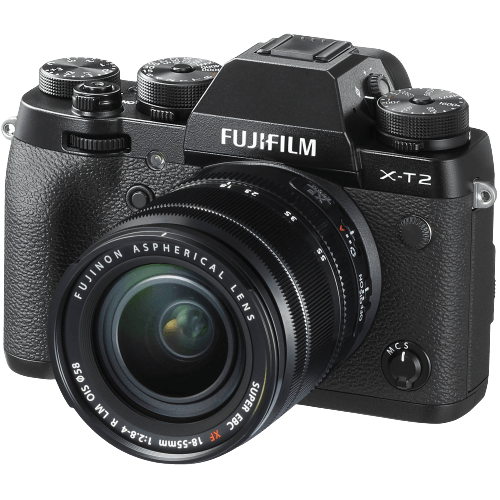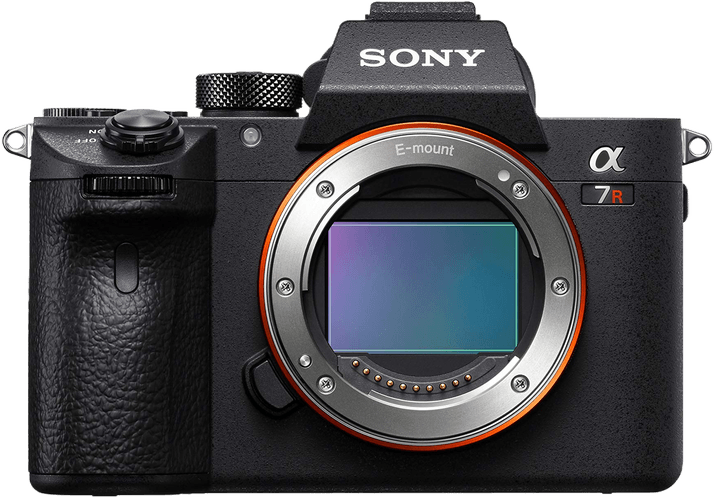Fujifilm X-T2 vs Sony a7R III Comparison
Fujifilm X-T2

Sony a7R III

The Sony a7R III outperforms the Fujifilm X-T2 with a score of 83/100 compared to 68/100. Both cameras are mirrorless and were released in 2016 and 2017, respectively. They share similarities in camera size, with the Fujifilm X-T2 measuring 133 x 92 x 49mm and the Sony a7R III at 127 x 96 x 74mm.
The Sony a7R III excels with a higher score, but it also comes with a heftier launch price of $3200 compared to the Fujifilm X-T2’s $1599. The Sony a7R III is heavier, weighing 657g, while the Fujifilm X-T2 weighs 507g.
Despite the price and weight differences, the Sony a7R III’s higher score justifies its advantages, making it a superior choice. However, the Fujifilm X-T2 is a more budget-friendly and lightweight option for those prioritizing these factors.
Fujifilm X-T2 vs Sony a7R III Overview and Optics
The Sony a7R III outperforms the Fujifilm X-T2 in optics with a score of 84/100, an 18-point lead over the X-T2’s 66/100. Both cameras share common features, such as CMOS sensors and lens mounts specific to their respective brands. However, the Sony a7R III surpasses the Fujifilm X-T2 in several aspects, while the X-T2 holds its own in a few areas.
The Sony a7R III boasts a higher megapixel count at 42.4, compared to the X-T2’s 24. Additionally, the a7R III has a full-frame sensor, providing better image quality and low-light performance than the X-T2’s APS-C sensor. The a7R III’s sensor also received a DXOMARK score of 100, a testament to its superior performance. Furthermore, the a7R III features image stabilization, which the X-T2 lacks, allowing for sharper images in low-light conditions and during handheld shooting.
On the other hand, the Fujifilm X-T2 has a faster shooting speed of 14 frames per second, compared to the Sony a7R III’s 10. This gives the X-T2 an edge in capturing fast-moving subjects and action scenes. However, this advantage is not enough to make up for the overall inferior optics compared to the Sony a7R III.
In terms of optics, the Sony a7R III is the clear winner. Its higher megapixel count, full-frame sensor, and image stabilization contribute to its superior performance. While the Fujifilm X-T2’s faster shooting speed is commendable, it does not compensate for the gap in optical quality. Photographers seeking the best optics should opt for the Sony a7R III, while those who prioritize shooting speed may still find value in the Fujifilm X-T2.
Fujifilm X-T2 vs Sony a7R III Video Performance
The Fujifilm X-T2 outperforms the Sony a7R III in video capabilities with a score of 83/100, a significant 27-point lead over the Sony a7R III’s 56/100. Both cameras have a maximum video resolution of 4K and video dimensions of 3840 x 2160, providing high-quality footage. However, the differences in their video features set them apart.
The Fujifilm X-T2 surpasses the Sony a7R III in terms of maximum video frame rate, offering 60fps compared to the Sony a7R III’s 30fps. This allows the Fujifilm X-T2 to capture smoother, more detailed video, particularly in fast-moving scenes or when recording sports and action. Additionally, the Fujifilm X-T2 has built-in time-lapse functionality, enabling users to create stunning time-lapse videos without needing external accessories or software.
On the other hand, the Sony a7R III’s lower video score does not mean it lacks quality. It still offers 4K resolution and 3840 x 2160 video dimensions, ensuring high-definition footage. However, its lower maximum video frame rate of 30fps and lack of built-in time-lapse functionality make it less versatile than the Fujifilm X-T2 for video enthusiasts.
In comparing the video capabilities of these two cameras, the Fujifilm X-T2 emerges as the superior choice due to its higher video score, faster maximum video frame rate, and built-in time-lapse functionality. The Sony a7R III, while still offering high-quality video, falls short in versatility and advanced video features. For users prioritizing video capabilities, the Fujifilm X-T2 is the recommended choice.
Fujifilm X-T2 vs Sony a7R III Features and Benefits
The Sony a7R III outperforms the Fujifilm X-T2 in features, scoring 83 out of 100 points compared to the X-T2’s 70 points. Both cameras share some specifications, such as a 3-inch screen size, flip screen, and the absence of GPS. They also both offer WiFi and Bluetooth connectivity.
The Sony a7R III stands out with its higher screen resolution of 1,440,000 dots, providing clearer and more detailed image previews. Additionally, the a7R III has a touchscreen, which allows for easier navigation and access to settings compared to the X-T2, which lacks this feature.
The Fujifilm X-T2, despite its lower score, may still offer advantages in specific situations. For example, some photographers may prefer the X-T2’s unique design and aesthetic or its compatibility with Fujifilm’s renowned X-series lenses. However, these factors do not significantly impact the camera’s features, as reflected in its lower score.
In comparing the features of the Fujifilm X-T2 and the Sony a7R III, the Sony a7R III is the clear winner due to its superior screen resolution and touchscreen capabilities. While the Fujifilm X-T2 may have its unique appeal, the Sony a7R III offers better functionality and user experience in terms of features.
Fujifilm X-T2 vs Sony a7R III Storage and Battery
The Fujifilm X-T2 slightly outperforms the Sony a7R III in storage and battery with a score of 68/100 compared to 65/100. Both cameras have two memory card slots and accept SD, SDHC, and SDXC cards (UHS-II compatible).
The X-T2 has an edge with its USB charging capability, which the a7R III lacks. This feature allows for more convenient charging options during travel or extended use. However, the X-T2 has a shorter battery life of 340 shots, using the NP-W126S battery type.
On the other hand, the Sony a7R III boasts an impressive battery life of 650 shots, almost double that of the X-T2, using the NP-FZ100 battery type. This advantage makes it ideal for longer shooting sessions without frequent battery swaps.
Taking these factors into account, the Fujifilm X-T2 excels in charging convenience, while the Sony a7R III shines in battery longevity.
Fujifilm X-T2 vs Sony a7R III – Our Verdict
Are you still undecided about which camera is right for you? Have a look at these popular comparisons that feature the Fujifilm X-T2 or the Sony a7R III:

